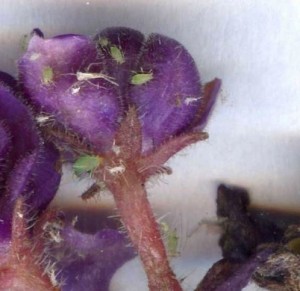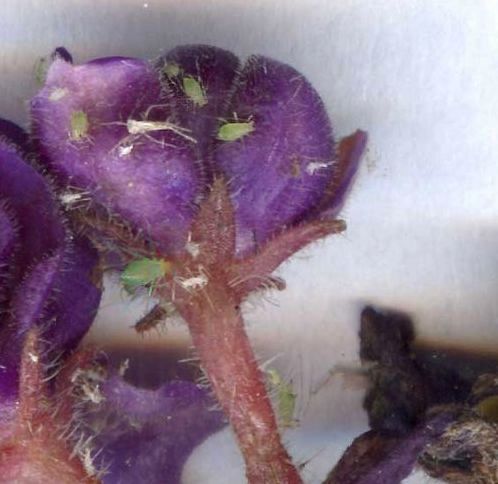Insects that damage the African violet: Small plant lice (Aphidinea)
 The Aphids suborder is by far and perhaps the largest group of insects. According to a modest estimate, this would include around 3000 species from all over the world. However, the calculation does not stop at this number, new and new species appear every year.
The Aphids suborder is by far and perhaps the largest group of insects. According to a modest estimate, this would include around 3000 species from all over the world. However, the calculation does not stop at this number, new and new species appear every year.
It is practically impossible to find a plant that has not been attacked by aphids at least once.
Aphids are homopterous insects, with a length of 0.2 – 5 mm. It moves slowly on the surface of the plant, they have a soft body and quite thin and fragile legs.
Their oral apparatus is type stung- sucked. Aphids feed exclusively on the cellular juice of plants.
Their color is varied: verde, many, Red, Yellow, grey, whitish. Some species has a black dot on the abdomen, imitating an opening left after the exit of a parasitic insect from the abdomen.
Many species can change color depending on the host plant, Temperature, season.
Saintpaulia is attacked only by a few species of aphids, typical of greenhouses.
This insect most often we meet the African violets bred in the greenhouse and put up for sale in specialty stores.
The size of the aphid, that damages African violet, not more than 2 mm. They are fragile insects, green or black in color. Have round body shape. Whiskers and legs are thin and long.
Larvae, on the outside, except for size, are no different from adult aphid. Females may have wings, but most of the time they are missing. In a colony of aphids, males may be missing.
Females can lay eggs, but most of the time they give birth to offspring, which allows a rapid multiplication of this insect. In these conditions the aphid can in a few weeks block the point of growth and flowering of the plant.
On the attacked plant, especially on the bottom of the leaves, peduncles and flowers, besides these small insects you can find whitish shells, left after the moulting of the larvae, a sticky substance secreted by them and sometimes ants.
The aphid pierces the soft surfaces of the plant and sucks the sap. Instead of the sting, plant tissues deform, then die. The flowers on the attacked peduncles do not develop and wither without opening. The pendulum itself withers and dies. Aphids suck off the surface of the plant a much larger amount of cellular juice than the daily requirement.
Excess water and carbohydrates is eliminated from the body of aphids in the form of sugary secretions, a sticky substance called in the people "honey dew". This substance covers the entire surface of the plant, hindering the breathing of the plant and creating an environment conducive to the development of saprophytic fungi and other viruses.
Saprophytic mushrooms, for example, can cover the leaf with a 'film' that decreases the intensity of photosynthesis, weakening even more the attacked plant.
In apartments and small greenhouses fighting aphids is not complicated at all. Aphid is easily and qualitatively combated with the following systemic insecticides: Mospilan, Actara, Dantop, Confidor Energy, Decided, Sinoratox, Carbetox, Diazol, Fastac etc..
It is recommended to use alternatively these insecticides, because aphids gain resistance to chemicals. The plant will splash and water with the insecticides in question once every 6-7 days, respecting exactly the dosage on the package. If after chemical treatment aphids appear again, the plant will be treated with another insecticide.
The effect of the insecticides used also depends on the temperature in the room.

